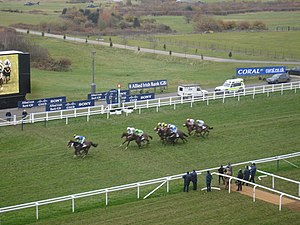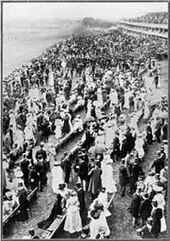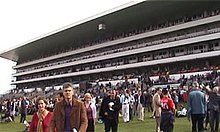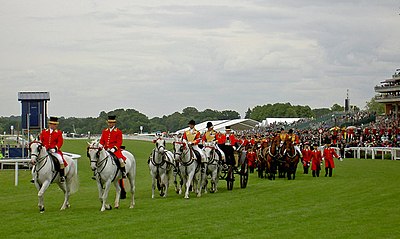Ascot Racecourse
File:Ascot racecourse logo.jpg | |
| Location | Ascot, Berkshire, England |
|---|---|
| Coordinates | 51°24′58″N 0°40′37″W / 51.41611°N 0.67694°W |
| Owned by | Ascot Racecourse Ltd |
| Date opened | 11 August 1711 |
| Screened on | Racing UK |
| Course type | Flat National Hunt |
| Notable races | The Gold Cup |
| Official website | |
Ascot Racecourse ("ascot" pronounced /ˈæskət/, often incorrectly pronounced /ˈæskɒt/) is a British racecourse, located in Ascot, Berkshire, England, which is used for thoroughbred horse racing. It is one of the leading racecourses in the United Kingdom, hosting nine of Britain's 32 annual Group 1 horse races.
The course, owned by Ascot Racecourse Ltd,[1] enjoys close associations with the British Royal Family, being approximately six miles from Windsor Castle.
Ascot today stages twenty-six days of racing over the course of the year, comprising eighteen flat meetings held between the months of May and October inclusive. It also stages important jump racing throughout the winter months. The Royal Meeting held each June, remains a major draw, its highlight being The Gold Cup. The most prestigious race is the King George VI and Queen Elizabeth Stakes run over the course in July.
History

Ascot Racecourse was founded in 1711 by Queen Anne. The first race, "Her Majesty's Plate", with a purse of 100 guineas, was held on 11 August 1711. Seven horses competed, each carrying a weight of 12 stones (76 kg). This first race comprised three separate four-mile (6437 m) heats.
In 1813 Parliament passed an Act to ensure that the grounds would remain a public racecourse. A new grandstand was opened in 1839 at a cost of £10000.[2] A further Act of Parliament of 1913 (Ascot Authority Act 1913 c.lxxxiv) establishing the Ascot Authority which entity manages the racecourse to this day. From its creation until 1945 the only racing that took place at Ascot was the Royal Meeting, a four-day event. Since that date, more fixtures have been introduced to the grounds, notably steeplechase and hurdles in 1965.

Ascot racecourse closed for a period of twenty months on 26 September 2004, for a £185 million redevelopment funded by Allied Irish Bank and designed by Populous and Buro Happold. As owner of the Ascot estate, Her Majesty Queen Elizabeth reopened the racecourse on Tuesday 20 June 2006.
Upon re-opening the new grandstand attracted criticism for failing to provide sufficiently raised viewing for patrons to watch the racing, and devoting too much space to restaurants, bars and corporate hospitality facilities. At the end of 2006 a £10 million programme of further alterations was announced to improve the viewing from lower levels of the grandstand using an innovative steel composite product ("SPS" sandwich plate system) to reprofile the existing concrete terraces. However, the upper levels provide far less accommodation for the everyday racegoer than was present in the former stand.[3]
In March 2009 it was confirmed that the main sponsors of Ascot, William Hill would be ceasing their sponsorship deal, citing that the decision by the BBC to reduce live race coverage as the main reason in its decision making process.[4]
In July 2009 Ascot Racecourse also hosted the third round of the UAE President's Cup.[5]
Royal Ascot
The Royal Ascot is the centrepiece of Ascot's year and dates back to 1711 when it was founded by Queen Anne. Every year Royal Ascot is attended by Elizabeth II and other members of the British Royal Family such as The Prince of Wales, arriving each day in a horse-drawn carriage with the Royal procession taking place at the start of each race day and the raising of the Queen's Royal Standard. It is a major event in the British social calendar, and press coverage of the attendees and what they are wearing often exceeds coverage of the actual racing. There are three enclosures attended by guests on Royal Ascot week.

The Royal Enclosure is the most prestigious of the three enclosures, with recent visits from the Queen and Royal Family members. Access to the Royal Enclosure is restricted, with high security on the day. First-time applicants must apply to the Royal Enclosure Office and gain membership from someone who has attended the enclosure for at least four years. For existing badgeholders, an invitation is sent out by Her Majesty's Representative[6] to request badges. The badgeholder's name is written onto the badge and can be used only by that person; the colours of the badges vary each day for one-day applicants. Those in the Royal Enclosure have the options of fine dining and hospitality, and a selection of bars. The dress code is strictly enforced. For women, only a day dress with a hat is acceptable, with rules applying to the length and style of the dress. In addition, women must not show bare midriffs or shoulders. For men, black or grey morning dress with top hat is required.
Over 300,000 people make the annual visit to Berkshire during Royal Ascot week, making this Europe’s best-attended race meeting. There are eighteen group races on offer, with at least one Group One event on each of the five days. The Gold Cup is on Ladies' Day on the Thursday.
In 2012, the Golden Jubilee Stakes was renamed the Diamond Jubilee Stakes, to commemorate Queen Elizabeth II's Diamond Jubilee.[7]
In 2013, the Windsor Forest Stakes was renamed the Duke of Cambridge Stakes, with the Queen’s consent, recognising the new title given to Prince William.[8]
In 2015, the newly created Commonwealth Cup became the eighth Group One race at Royal Ascot, replacing the Buckingham Palace Stakes.[9]
In 2016, total prize money across the five days of Royal Ascot was £6,580,000.[10] This was £1,000,000 more than the prize money on offer at the meeting in 2015, representing an overall increase of 18%. Races with notable prize money increases for 2016 included the Prince of Wales's Stakes (£750,000 from £525,000), the Queen Anne Stakes (£600,000 from £375,000) and the Diamond Jubilee Stakes (£600,000 from £525,000), while the other Group One races all had their prize money increased to £400,000. The Gold Cup in 2016 was run as "The Gold Cup in Honour of The Queen's 90th Birthday".
| Month | DOW | Race Name | Grade | Distance | Age/Sex |
|---|---|---|---|---|---|
| June | Tuesday | Queen Anne Stakes | Group 1 | 1m | 4yo + |
| June | Tuesday | Coventry Stakes | Group 2 | 6f | 2yo only |
| June | Tuesday | King's Stand Stakes | Group 1 | 5f | 3yo + |
| June | Tuesday | St James's Palace Stakes | Group 1 | 1m | 3yo C only |
| June | Tuesday | Ascot Stakes | Handicap | 2m 4f | 4yo + |
| June | Tuesday | Windsor Castle Stakes | Listed | 5f | 2yo only |
| June | Wednesday | Jersey Stakes | Group 3 | 7f | 3yo only |
| June | Wednesday | Queen Mary Stakes | Group 2 | 5f | 2yo F only |
| June | Wednesday | Duke of Cambridge Stakes | Group 2 | 1m | 4yo + FM |
| June | Wednesday | Prince of Wales's Stakes | Group 1 | 1m 2f | 4yo + |
| June | Wednesday | Royal Hunt Cup | Handicap | 1m | 3yo + |
| June | Wednesday | Sandringham Stakes | Handicap | 1m | 3yo F only |
| June | Thursday | Norfolk Stakes | Group 2 | 5f | 2yo only |
| June | Thursday | Hampton Court Stakes | Group 3 | 1m 2f | 3yo only |
| June | Thursday | Ribblesdale Stakes | Group 2 | 1m 4f | 3yo F only |
| June | Thursday | Gold Cup | Group 1 | 2m 4f | 4yo + |
| June | Thursday | Britannia Stakes | Handicap | 1m | 3yo CG only |
| June | Thursday | King George V Stakes | Handicap | 1m 4f | 3yo only |
| June | Friday | Albany Stakes | Group 3 | 6f | 2yo F only |
| June | Friday | King Edward VII Stakes | Group 2 | 1m 4f | 3yo CG only |
| June | Friday | Commonwealth Cup | Group 1 | 6f | 3yo only |
| June | Friday | Coronation Stakes | Group 1 | 1m | 3yo F only |
| June | Friday | Duke of Edinburgh Stakes | Handicap | 1m 4f | 3yo + |
| June | Friday | Queen's Vase | Group 2 | 1m 6f | 3yo only |
| June | Saturday | Chesham Stakes | Listed | 7f | 2yo only |
| June | Saturday | Wolferton Stakes | Handicap | 1m 2f | 4yo + |
| June | Saturday | Hardwicke Stakes | Group 2 | 1m 4f | 4yo + |
| June | Saturday | Diamond Jubilee Stakes | Group 1 | 6f | 4yo + |
| June | Saturday | Wokingham Stakes | Handicap | 6f | 3yo + |
| June | Saturday | Queen Alexandra Stakes | Conditions | 2m 5f 159y | 4yo + |
British Champions Day
Since 2011, Ascot has staged British Champions Day, the climax to the British Champions Series, an event designed to increase the sport's public profile and to rival Arc weekend and the Breeders' Cup in terms of attracting the best horses.[11] The first event was staged on 15 October 2011 and was generally regarded as a success, though overshadowed by controversy regarding new regulations on the use of the whip. Winners on British Champions Day have included Frankel, who won the Queen Elizabeth II Stakes in 2011, and in the final race of his unbeaten career, the Champion Stakes in 2012.
| Month | DOW | Race Name | Grade | Distance | Age/Sex |
|---|---|---|---|---|---|
| October | Saturday | British Champions Sprint Stakes | Group 1 | 6f | 3yo + |
| October | Saturday | British Champions Long Distance Cup | Group 2 | 2m | 3yo + |
| October | Saturday | British Champions Fillies' and Mares' Stakes | Group 1 | 1m 4f | 3yo + fm |
| October | Saturday | Queen Elizabeth II Stakes | Group 1 | 1m | 3yo + |
| October | Saturday | Champion Stakes | Group 1 | 1m 2f | 3yo + |
Notable races
| Month | DOW | Race Name | Type | Grade | Distance | Age/Sex |
|---|---|---|---|---|---|---|
| January | Saturday | Holloway's Hurdle | Hurdle | Grade 2 | 2m 3f 110y | 4yo + |
| January | Saturday | Clarence House Chase | Chase | Grade 1 | 2m 1f | 5yo + |
| January | Saturday | Warfield Mares' Hurdle | Hurdle | Grade 2 | 3m | 4yo + m |
| February | Saturday | Reynoldstown Novices' Chase | Chase | Grade 2 | 3m | 5yo + |
| February | Saturday | Ascot Chase | Chase | Grade 1 | 2m 5f 110y | 5yo + |
| February | Saturday | Weatherbys Chase | Chase | Handicap | 3m | 5yo + |
| April | Wednesday | Sagaro Stakes | Flat | Group 3 | 2m | 4yo + |
| April | Wednesday | Pavilion Stakes | Flat | Group 3 | 6f | 3yo only |
| April | Wednesday | Paradise Stakes | Flat | Listed | 1m | 4yo + |
| May | Saturday | Victoria Cup | Flat | Handicap | 7f | 4yo + |
| July | Saturday | Summer Mile Stakes | Flat | Group 2 | 1m | 4yo + |
| July | Saturday | Princess Margaret Stakes | Flat | Group 3 | 6f | 2yo only f |
| July | Saturday | King George VI and Queen Elizabeth Stakes | Flat | Group 1 | 1m 4f | 3yo + |
| July | Saturday | Pat Eddery Stakes | Flat | Listed | 7f | 2yo only |
| October | Friday | Noel Murless Stakes | Flat | Listed | 1m 6f | 3yo |
| October | Saturday | Bengough Stakes | Flat | Group 3 | 6f | 3yo + |
| October | Saturday | Cumberland Lodge Stakes | Flat | Group 3 | 1m 4f | 3yo + |
| October | Saturday | Cornwallis Stakes | Flat | Group 3 | 5f | 2yo only |
| Oct / Nov | Saturday | Sodexo Gold Cup | Chase | Grade 3 | 3m | 4yo + |
| November | Saturday | Ascot Hurdle | Hurdle | Grade 2 | 2m 3f 110y | 4yo + |
| November | Saturday | Amlin 1965 Chase | Chase | Grade 2 | 2m 3f | 4yo + |
| December | Friday | Championship Standard Open NH Flat Race | N H Flat | Listed | 2m | 4yo-6yo |
| December | Friday | Noel Novices' Chase | Chase | Grade 2 | 2m 3f | 4yo + |
| December | Friday | Kennel Gate Novices' Hurdle | Hurdle | Grade 2 | 2m | 4yo + |
| December | Saturday | Wessex Youth Trust Handicap Hurdle | Hurdle | Grade 3 | 2m | 4yo + |
| December | Saturday | Ascot Silver Cup | Chase | Handicap | 3m | 4yo + |
| December | Saturday | Long Walk Hurdle | Hurdle | Grade 1 | 3m 1f | 4yo + |
Shergar Cup
The Shergar Cup is an annual horse racing event held at Ascot, usually during early August. The event is named in honour of Shergar, the horse that won the 1981 Epsom Derby, and was originally sponsored by Shergar's owner, the Aga Khan. The event is currently sponsored by Dubai Duty Free.
Royal Ascot Cricket Club & Ascot United
The racecourse is also home to Royal Ascot Cricket Club, which was founded in 1897 and their ground is situated in the middle of the racecourse. Ascot United F.C. are located towards the eastern side of the site.[12] A new clubhouse, stand and floodlighting have recently been erected.
In popular culture
The racecourse is the setting for a scene in the musical My Fair Lady and the subject for the song "Ascot Gavotte".
The racecourse was used as a filming location in the James Bond film A View to a Kill (1985), where Bond (played for the last time by Roger Moore) was beginning his mission to defeat the villainous Max Zorin (Christopher Walken), whose horse was racing there.
The James Bond production crew returned to Ascot Racecourse for Skyfall (2012), where it stood in for Shanghai Pudong International Airport.[13]
Gallery
-
Main straight
-
Front entrance to the 2006 Ascot Stands
-
The redeveloped stand
-
The redeveloped stand from inside
-
Dress & conduct rules for racegoers at Ascot – see at full size.
-
AscotStand from north west
References
- ^ "About Ascot Racecourse".
- ^ Whyte, James Christie (1840). History of the British turf, from the earliest period to the present day, Volume I. London: H. Colburn. pp. 199–200. Retrieved 1 May 2013.
- ^ www.ascot.co.uk
- ^ "Hills to end backing for jump racing at Ascot". Racing Post. 15 March 2009. Retrieved 29 April 2009.
- ^ Ascot Racecourse hosts UAE President's cup in England Archived 6 July 2011 at the Wayback Machine, wam.org.ae, 26 July 2009, accessed 6 August 2009.
- ^ Mosley, Charles (ed.) (2003). Burke's Peerage & Baronetage, 107th edn. London: Burke's Peerage & Gentry Ltd. p. 1332 (ERNE, E). ISBN 0-9711966-2-1.
{{cite book}}:|first=has generic name (help) - ^ "Royal Ascot prepares for star names at Diamond Jubilee festival". BBC. Retrieved 18 July 2016.
- ^ "Prize money for Royal Ascot hits £5 million". Racing Post. Retrieved 18 July 2016.
- ^ "New Group One sprint at Royal Ascot to be named the Commonwealth Cup". ascot.co.uk. Retrieved 18 July 2016.
- ^ "£1m boost to Royal Ascot prize fund". ascot.co.uk. Retrieved 18 July 2016.
- ^ "2011 British Champions Series unveiled". Jockey Club. Retrieved 18 July 2016.
- ^ "Ascot United". Retrieved 23 September 2011.
- ^ Mathieson,, Amy. "Ascot racecourse to star in James Bond film". Horse and Hound. Archived from the original on 12 October 2012. Retrieved 30 November 2012.
{{cite web}}: Unknown parameter|deadurl=ignored (|url-status=suggested) (help)CS1 maint: extra punctuation (link)
External links
- Main Ascot website
- Royal Ascot website
- BBC Royal Ascot interactive guide
- Course guide on GG.COM
- Royal Ascot Guide
- Royal Ascot Bloodline Interactive Tool








